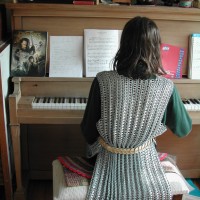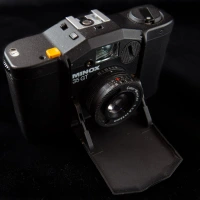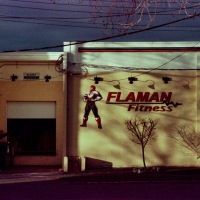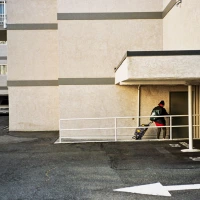Ants Sipping Iris Nectar – Time Lapse

This macro time-lapse of ants sipping nectar from the stem of an Iris flower shows the value of this method. It is part of my Iris series, and the sub-series Iris Bugs. When I set this shot up all I knew was the ants seemed to come and go from this part of the plant quite often. It was only when I viewed the time-lapse series did I see that the ants were drinking from little drops that are regularly emitting from the stem of this flower. If you look at the left hand side, where it is in focus, you can see the drop forming over and over – in fact in this video, it forms 46 times in 32 minutes, and is sipped 45 times. But the one on the left is not the only one; if you watch carefully you can see that the ants are cleaning up drops of water in a chain all the way around the stem at about the same height – mostly in the closer areas that are out of focus. The photo above illustrates two of the droplet locations.
To view the video click on the image below.
 I find that viewing it at high-resolution in WordPress runs a bit rough and recommend you move over to YouTube and watch if full screen at high-resolution.
I find that viewing it at high-resolution in WordPress runs a bit rough and recommend you move over to YouTube and watch if full screen at high-resolution.
.
Unfortunately the wind was blowing and even though I had secured the plant, it was not enough to prevent it shifting, and my efforts at correcting this with crop adjustments were not up to the task either.
I became interested in the regularity of the sipping visits by ants, and looked at the time each image was taken. The images were 2 seconds apart. I learned, looking at these shots, that when the ant starts to drink they bend their antennae at right angles down to the plant surface, as is visible in the top image where both ants are drinking at the same time from different drops.

.
Normally when they are cruising about the antennae are unbent as you can see in the images above and below, or only one of them bends as they pass something of interest (I guess). So, in the sequences, the first one that has right angle bends in the antennae was the one I counted as the start of sipping time. What I found is that in this half hour, the median time between sips was 36 seconds, the mean was 41 and standard deviation 26 seconds. So not all that regular, except that there seemed to be patterns within the overall numbers. For instance, of the first 6 sips observed, three are at 15 seconds after the start of the minute, one is 17 seconds (given the shooting interval it too could have been 15) while the other two are at 5 and 1 seconds. Thus it could be argued that these ants wear watches and can read the time.

.
This kind of pattern is hinted at a few times here and there. I suspect that there is a route the ants are working and that it takes a certain amount of time. What throws it off is probably the number of ants working, and perhaps other distractions, like the arrival of a bee (or is it a fly in disguise?) that flew into the photo just as I was documenting the set up for this time-lapse, which was shooting at the time. In the image below, you can see an ant, bracketed between the antennae of the bee. You will notice also in the background a bamboo stake that I used to secure the whole plant, and the rubber band over a petal and the end of the lens which served to keep the plant a fixed distance (more or less) from the lens and thus in focus for the series.

.
A large black and white bumblebee also checked in, as can be partly seen below. The image below is less heavily cropped than the rest which were designed so that the video gave as close a look as possible at the feeding behaviours.

.
Of all the 970 photos in this series there are only 4 or 5 that have 3 ants in them at one time. Two ants are more common, but mostly if there is an ant, there is only one. I think this supports the idea that it is the number of ants that influences most heavily the frequency of sips. I did not plot those data against the length of time between sips, but maybe I will one day.
The chart below shows the number of seconds between each sip from the left most droplet in the video.

The next chart indicates where the second hand was when sips were taken – the longer the triangle, the more sips at that point in the clock face. The circles in the chart are one sip each. You can see that there is a 10 to 2 pattern as well as a 20 past 8 trend. We all know that the 10 to 2 pattern (EDIT: or as Ken corrects below, 10 past 10) originates with Timex advertising, but the other one I am less sure about. This probably indicates that ants use Timex watches, and another brand, yet to be determined. A pretty chart, but perhaps meaningless without more data. And a super high macro of a watch on one of those spiky legs.


.
My set up for this time-lapse included my old Canon 50/3.5 lens, reversed on the end of an extension tube. This combination with a full frame sensor gives x2 magnification. I cropped the images as well, so the total magnification is equivalent to about x2.6 in this video. The lens was set on manual aperture at f-22, but what that is in real terms I have no idea – f-50? I forgot to set the camera to manual exposure as well. The aperture priority mode resulted in quite a bit of flickering with exposures from 1/40th to 1/80th, varying with the movements in the flower, and nearby ones in the background I expect. LRTimelapse dealt well with the flickering.
What I had to deal with manually was the plant movement which I did by adjusting the cropping at key points and letting LRTimelapse infill the crop values to intervening images. I got rid of the biggest movements that way, but the smaller ones, and the ones closer and further from the camera were either impossible to fix, or just not worth the time. Next time, I will find some way of clamping the plant more securely. Another mistake was shooting in live-view. I wanted to reduce camera shake from the mirror, and that probably did help. However, in live view mode, at full resolution, I was unable to shoot at the 1 second interval I set on the intervalometer. Two seconds seems the minimum possible. I should have shot at a lower resolution as well, it would have speeded up processing time, might have allowed a shorter interval in live view and I did not need the extra resolution to provide space for zooming or panning.

.
Technical Details: Canon EOS 5Dmkii, Canon FD 50mm/3.5 macro, Canon Life Size Adaptor and reversal ring, ISO1000, f22, 1/80th second (mostly), 969 images in total, taken 2 seconds apart with the aid of a Pixel TW-282 timer. Aperture priority, auto white balance (tch tch), RAW files shot at 5616 x 3744, cropped to 3562 x 2034 pixels. Edited in Lightroom 4 and LRTimelapse 2.3.1, then rendered as a movie through LR4 Slideshow module, with LRTimelapse templates. Titles added in Windows Live Movie Maker. Stills also processed in Topaz Clarity. Location shots taken with Canon G15.
.
.











Pingback: Iris Bug VII | burnt embers
Very cool, Ehpem! Fascinating motion capture.
LikeLike
Thanks Lynn – I am glad you like it. The miniature life in our gardens is full of fascination.
If I do more in the garden I am going to have to choose a windless day (we don’t get those around here) or tie things down somehow.
LikeLike
Pingback: 88 Amazing Photography Links That You Won't Want to Miss
Very impressive, ehpem, your little video gives me whole new appreciation for this time lapse technique.
LikeLike
Thanks Joseph. It had the same effect on me! Ever present clouds rolling around in the sky seems less informative sped up than does the behaviour of tiny creatures difficult to see at the best of times. And, it takes us back to the roots of photography as a scientific tool, Eadweard Muybridge’s running horse springs to mind.
LikeLike
Very cool. Just shows how much we don’t usually notice.
LikeLike
Thanks skadhu. There are so many things like this. I would think that with good eyesight, good light and a lot of patience one could figure out what these ants are up to. But the timelapse sure helps bring it out.
LikeLike
This is truly fascinating!
LikeLike
Thanks Lisa! I love the way that time-lapse photography reveals all kinds of things.
LikeLike
As Spock would say- “Fascinating!” (with the !). Very smooth TL and I’ve always found ants to be interesting to watch. Speaking of watches, one minor correction; the Timex pattern is a 10 after 10 pattern but I’ve been unable to classify the 8:20 pattern.
I think this is the first time we’ve seen the macro rig this close. The rubber band reminds me of some of the tools I have used myself in some shots; rubber bands, paper clips, twist ties, duct tape, electrical tape and gaffers tape. The list goes on. Great post!
LikeLike
Hi Ken. Fascinating IS a good word for it. I inserted an edit to correct the wrong time – I wonder if the ants can tell the difference between 10 past 10 and 10 to 2. Especially written out in a confusing manner like that. I am thinking the other pattern might be a super cheap, unreliable watch as there seems some variation in accuracy. My theory won’t accommodate more than two watches, one additional possibility to Timex makes it a robust proposal, but beyond that it gets ridiculous because of implications regarding materials acquisition, shopping patterns and an online bugBay, Antazon or equivalent.
This actually is the first time that I have put this particular combination on the camera, so it is the first time we have all seen it. I did show a shot of a Lumix with all of this kit on the bellows unit which I used while waiting for my EOS-FD adapter to arrive (my son had an FD-Micro 4/3s adapter). You can see that shot here: http://wp.me/p1R4lY-3Vj. I am quite pleased to discover that I have quite compact lens/tube combination that will do X2 shots. The bellows unit is just too unwieldy to be using out of doors much, and hand holding is impossible. Mind you, hand holding at X2 is not very successful either, as I learned yesterday.
I have heard that people have clamps on the ends of flexible and yet rigid arms that they can clamp to their tripod and to the subject. If I keep on doing this kind of shot, I might need to rig something like that. Thanks for the list of materials – I think I have most of it to hand!
LikeLike